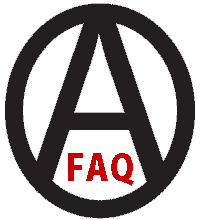
The Anarchist FAQ
Liberty is the mother, not the daugher, of order.
VII. Do you have symbols & art?
Anarchists have used symbolism in our revolt against the State, the most famous of which are the circled-A and the black flag. Here we give the history of these iconic symbols and indicate why they were taken up by anarchists to represent our ideas and movement.
Ironically enough, one of the original anarchist symbols was the red flag. As anarchist Communard Louise Michel put it, “Lyon, Marseille, Narbonne, all had their own Communes, and like ours [in Paris], theirs too were drowned in the blood of revolutionaries. That is why our flags are red. Why are our red banners so terribly frightening to those persons who have caused them to be stained that colour?” [The Red Virgin: Memoirs of Louise Michel, p. 65] March 18, 1877, saw Kropotkin participate in a protest march in Berne which involved the anarchists “carrying the red flag in honour of the Paris
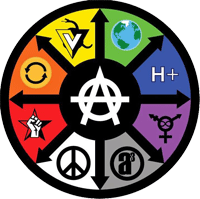 Commune” for “in Switzerland federal law prohibited public display of the red flag.” [Martin A. Miller, Kropotkin, p. 137] Anarchist historians Nicolas Walter and Heiner Becker note that “Kropotkin always preferred the red flag.” [Peter Kropotkin, Act for Yourselves, p. 128] On Labour Day in 1899, Emma Goldman gave lectures to miners in Spring Valley, Illinois, which ended in a demonstration which she headed “carrying a large red flag.” Living My Life, vol. 1, p. 245] According to historian Caroline Waldron Merithew, the 300 marchers “defied police orders to haul down the ‘red flag of anarchy.’” [Anarchist Motherhood, p. 236]
Commune” for “in Switzerland federal law prohibited public display of the red flag.” [Martin A. Miller, Kropotkin, p. 137] Anarchist historians Nicolas Walter and Heiner Becker note that “Kropotkin always preferred the red flag.” [Peter Kropotkin, Act for Yourselves, p. 128] On Labour Day in 1899, Emma Goldman gave lectures to miners in Spring Valley, Illinois, which ended in a demonstration which she headed “carrying a large red flag.” Living My Life, vol. 1, p. 245] According to historian Caroline Waldron Merithew, the 300 marchers “defied police orders to haul down the ‘red flag of anarchy.’” [Anarchist Motherhood, p. 236]
This should be unsurprising since the anarchists mentioned above were all socialists of some type, and were part of the general socialist and labour movements. However, as mainstream socialism developed in the nineteenth century into the statist socialism of the revolutionary Marxists, anarchists developed their own images.
VII.A - Generic Anarchy Symbols
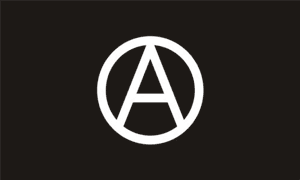
The most popular and well-known symbol is the cirled A. It is both easy to draw and easy to recognize. However, it is actually pretty new, dating from the late 20th century. The oldest symbols were flags. Both the black and red-and-black flags were first used by early revolutionary anarcho-socialists. The black flag was popularised in the 1880s by Louise Michel, a leading French communist-anarchist militant. From Europe it spread to America when the communist-anarchists of the International Working People’s Association raised it in their struggle against capitalism before being taken up by other revolutionary class struggle anarchists across the globe. The red-and-black flag of anarcho-socialism was first used by the Italian section of the First International and this had been the first to move from collectivist to communist-anarchism in October 1876. [Nunzio Pernicone, Italian Anarchism, 1864–1892, p. 111] From there, it spread to Mexico and was used by anarchist labour militants there before being re-invented by the Spanish anarcho-syndicalists in the 1930s.
VII.A.1 - What is the history of the Black Flag?
The black flag is the second most well-recognized symbol of anarchism. Howard Ehrlich has a passage in his book Reinventing Anarchy, Again on why anarchists use it. It is worth quoting at length:
Why is our flag black? Black is a shade of negation. The black flag is the negation of all flags. It is a negation of nationhood which puts the human race against itself and denies the unity of all humankind. Black is a mood of anger and outrage at all the hideous crimes against humanity perpetrated in the name of allegiance to one state or another. It is anger and outrage at the insult to human intelligence implied in the pretences, hypocrisies, and cheap chicaneries of governments ... Black is also a colour of mourning; the black flag which cancels out the nation also mourns its victims the countless millions murdered in wars, external and internal, to the greater glory and stability of some bloody state. It mourns for those whose labour is robbed (taxed) to pay for the slaughter and oppression of other human beings. It mourns not only the death of the body but the crippling of the spirit under authoritarian and hierarchic systems; it mourns the millions of brain cells blacked out with never a chance to light up the world. It is a colour of inconsolable grief.
But black is also beautiful. It is a colour of determination, of resolve, of strength, a colour by which all others are clarified and defined. Black is the mysterious surrounding of germination, of fertility, the breeding ground of new life which always evolves, renews, refreshes, and reproduces itself in darkness. The seed hidden in the earth, the strange journey of the sperm, the secret growth of the embryo in the womb all these the blackness surrounds and protects.
So black is negation, is anger, is outrage, is mourning, is beauty, is hope, is the fostering and sheltering of new forms of human life and relationship on and with this earth. The black flag means all these things. We are proud to carry it, sorry we have to, and look forward to the day when such a symbol will no longer be necessary. — Reinventing Anarchy, Again, “Why the Black Flag?”, Howard Ehrlich (ed.), pp. 31–2
Louise Michel, famous participant in the Paris Commune of 1871, was instrumental in popularising the use of the Black Flag in anarchist circles. At a March 18 public meeting in 1882 to commemorate the Paris Commune she proclaimed that the “red flag was no longer appropriate; [the anarchists] should raise the black flag of misery.” [Edith Thomas, Louise Michel, p. 191] The following year she put her words into action. According to anarchist historian George Woodcock, Michel flew the black flag on March 9, 1883, during demonstration of the unemployed in Paris, France. An open air meeting of the unemployed was broken up by the police and around 500 demonstrators, with Michel at the front carrying a black flag and shouting “Bread, work, or lead!” marched off towards the Boulevard Saint-Germain. The crowd pillaged three baker’s shops before the police attacked. Michel was arrested and sentenced to six years solitary confinement. Public pressure soon forced the granting of an amnesty. [Anarchism, pp. 251–2] August the same year saw the publication of the anarchist paper Le Drapeau Noir (The Black Flag) in Lyon which suggests that it had become a popular symbol within anarchist circles. [“Sur la Symbolique anarchiste”, Bulletin du CIRA, no. 62, p. 2] However, anarchists had been using red-and-black flags a number of years previously so Michel’s use of the colour black was not totally without precedence.
Not long after, the black flag made its way to America. Paul Avrich reports that on November 27, 1884, it was displayed in Chicago at an anarchist demonstration. According to Avrich, August Spies, one of the Haymarket martyrs, “noted that this was the first occasion on which [the black flag] had been unfurled on American soil.” By January the following year, “[s]treet parades and mass outdoor demonstrations, with red and black banners ... were the most dramatic form of advertisement” for the revolutionary anarchist movement in America. April 1885 saw Lucy Parsons and Lizzie Holmes at the head of a protest march “each bearing a flag, one black, the other red.” [The Haymarket Tragedy, p. 145, pp. 81–2 and p. 147] The Black Flag continued to be used by anarchists in America, with one being seized by police at an anarchist organised demonstration for the unemployed in 1893 at which Emma Goldman spoke. [Emma Goldman: A Documentary History of the American Years, vol. 1, p. 144] Twenty one years later, Alexander Berkman reported on another anarchist inspired unemployed march in New York which raised the black flag in “menacing defiance in the face of parasitic contentment and self-righteous arrogance” of the “exploiters and well-fed idlers.” [“The Movement of the Unemployed”, Anarchy! An Anthology of Emma Goldman’s Mother Earth, p. 341]
While the events above are fairly well known, as has been related, the exact origin of the black flag is not. What is known is that a large number of Anarchist groups in the early 1880s adopted titles associated with black. In July of 1881, the Black International was founded in London. This was an attempt to reorganise the Anarchist wing of the recently dissolved First International. In October 1881, a meeting in Chicago lead to the International Working People’s Association being formed in North America. This organisation, also known as the Black International, affiliated to the London organisation. [Woodcock, Op. Cit., pp. 212–4 and p. 393] These two conferences are immediately followed by Michel’s demonstration (1883) and the black flags in Chicago (1884).
Thus it was around the early 1880s that anarchism and the Black Flag became inseparably linked. Avrich, for example, states that in 1884, the black flag “was the new anarchist emblem.” [The Haymarket Tragedy, p. 144] In agreement, Murray Bookchin reports that “in later years, the Anarchists were to adopt the black flag” when speaking of the Spanish Anarchist movement in 1870. [The Spanish Anarchists, p. 57] Walter and Heiner also note that “it was adopted by the anarchist movement during the 1880s.” [Kropotkin, Act for Yourselves, p. 128]
VII.A.2 - Where does the circled-A come from?

The circled-A is, perhaps, even more famous than the Black and Red-and-Black flags as an anarchist symbol (probably because it lends itself so well to graffiti). According to Peter Marshall the “circled-A” represents Proudhon’s maxim “Anarchy is Order.” [Demanding the Impossible p. 558] Peter Peterson also adds that the circle is “a symbol of unity and determination” which “lends support to the off-proclaimed idea of international anarchist solidarity.” [“Flag, Torch, and Fist: The Symbols of Anarchism”, Freedom, vol. 48, No. 11, pp. 8]
However, the origin of the “circled-A” as an anarchist symbol is less clear. Many think that it started in the 1970s punk movement, but it goes back to a much earlier period. According to Peter Marshall, “[i]n 1964 a French group, Jeunesse Libertaire,
gave
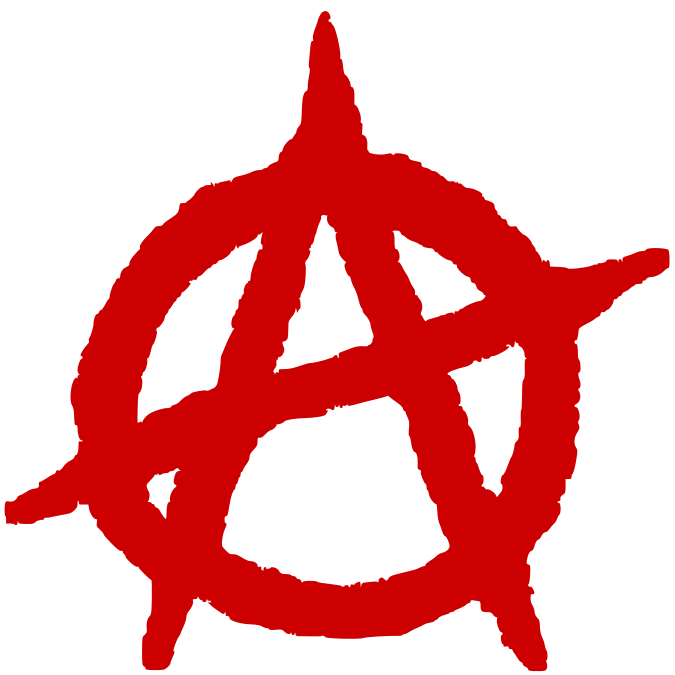 new impetus to Proudhon’s slogan ‘Anarchy is Order’ by creating the circled-A a
symbol which quickly proliferated throughout the world.” [Op. Cit., p. 445]
new impetus to Proudhon’s slogan ‘Anarchy is Order’ by creating the circled-A a
symbol which quickly proliferated throughout the world.” [Op. Cit., p. 445]
This is not the earliest sighting of this symbol. On November 25 1956, at its foundation in Brussels, the Alliance Ouvriere Anarchiste (AOA) adopted this symbol. Going even further, a BBC documentary on the Spanish Civil War shows an anarchist militia member with a “circled-A” clearly on the back of his helmet. Other than this, there is little know about the “circled-A“s origin.
Today the circled-A is one of the most successful images in the whole field of political symbolising. Its “incredible simplicity and directness led [it] to become the accepted symbol of the restrengthened anarchist movement after the revolt of 1968” particularly as in many, if not most, of the world’s languages the word for anarchy begins with the letter A. [Peterson, Op. Cit., p. 8]
VII.B - Symbols for Specific Branches

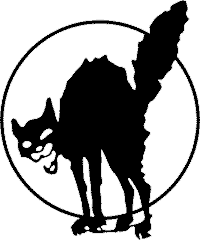
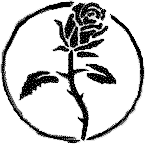
All of the various schools of anarchism have their particular symbols. Many are variations or colors of the circle-A symbol. For example, green anarchism uses a green circle-A, while anarcha-feminism and queer anarchism often use a pink one. Another variation is to use an additional symbol within the circle, such as a dollar sign for anarcho-capitalism, or a black cat or hammer for anarcho-syndicalism.
The "color codes" are similar for flags. The red and black flag stands for anarcho-communism or (with a black cat sometimes added) for anarcho-syndicalism. A green and black flag stands for green anarchism, while a gold and black flag stands for anarcho-capitalism. Orange and black is associated with mutalism.
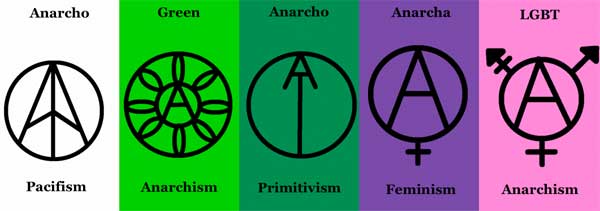
One can find all these symbols and more by doing a web image search on "anarchism symbols."